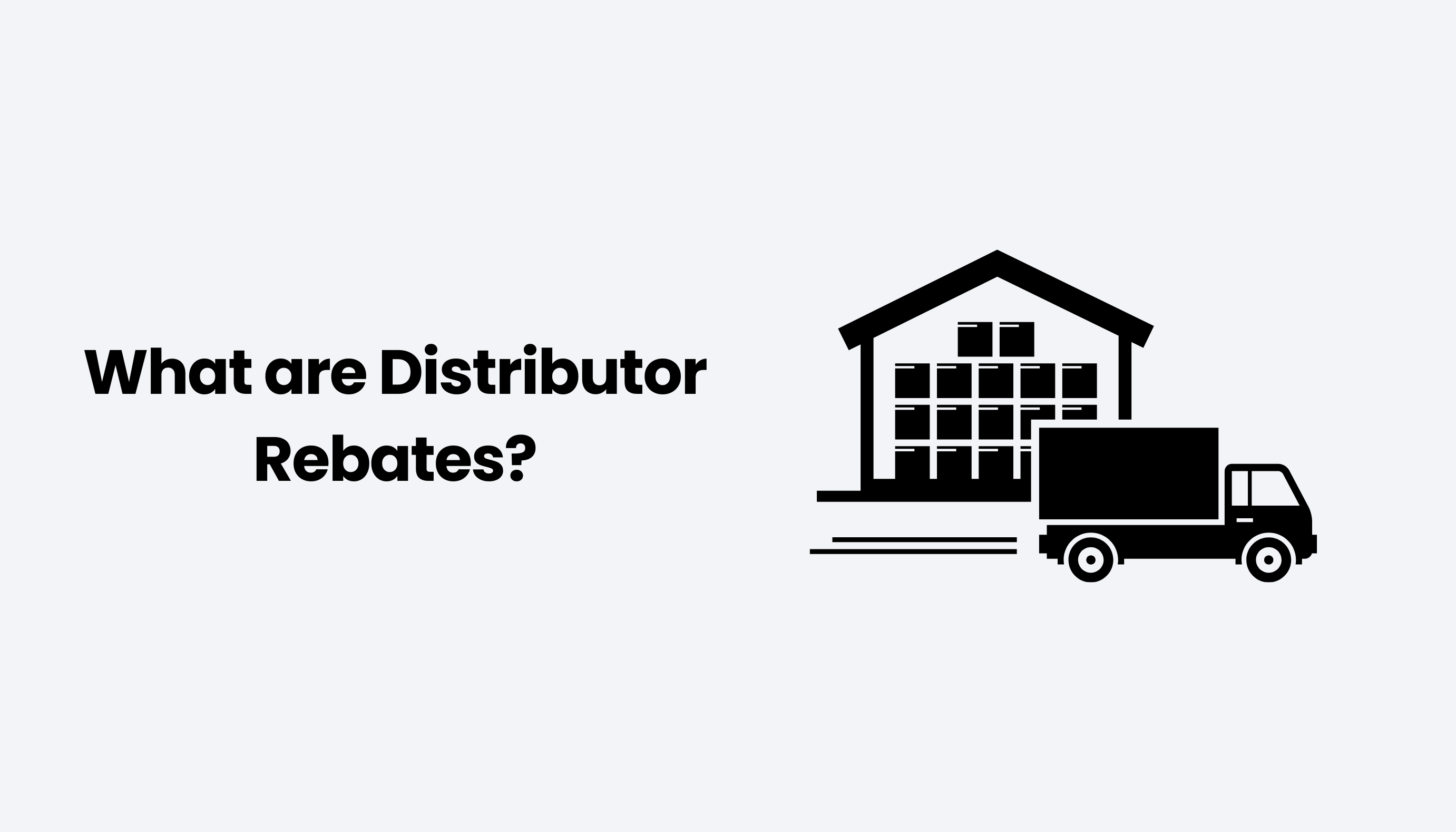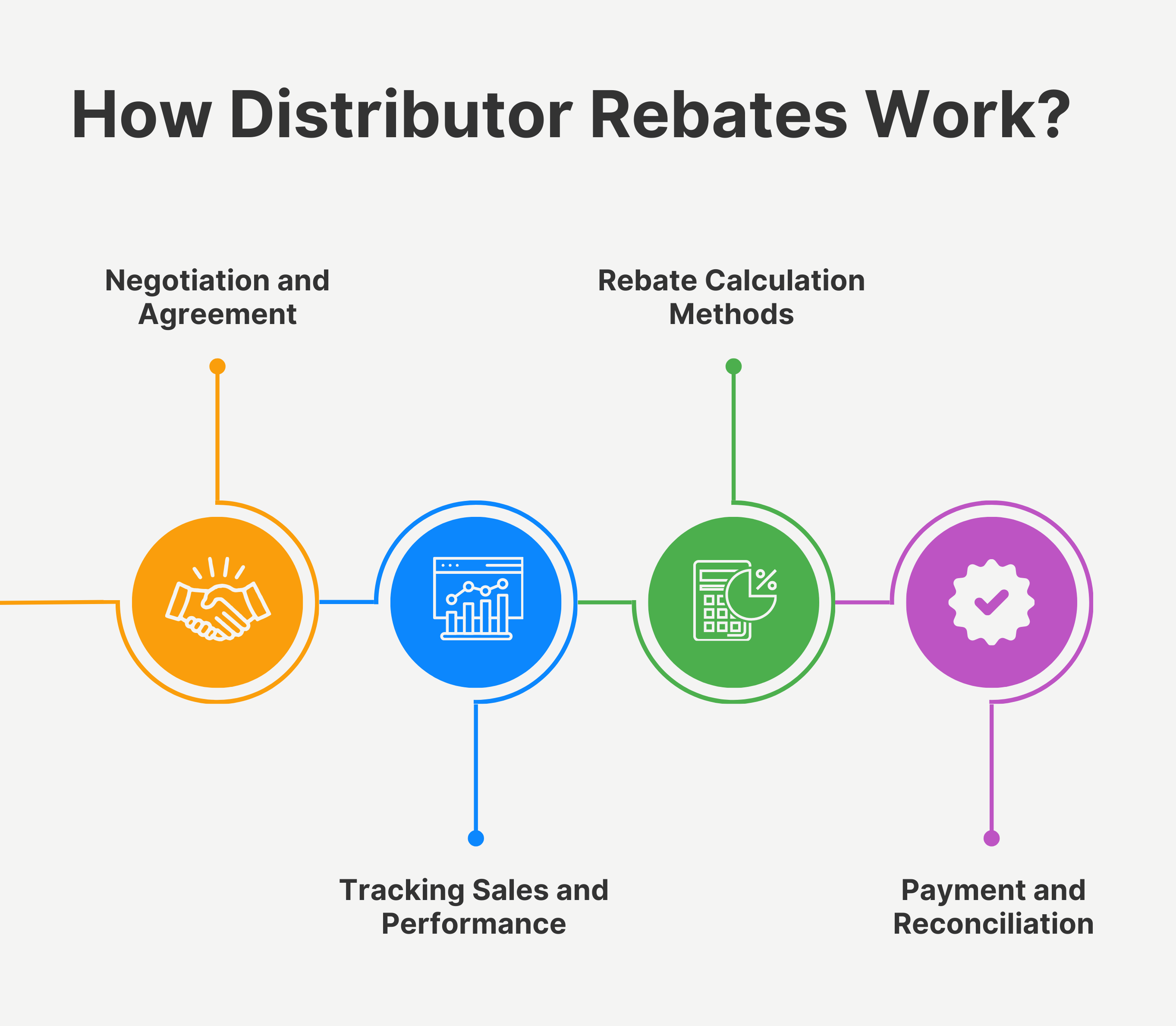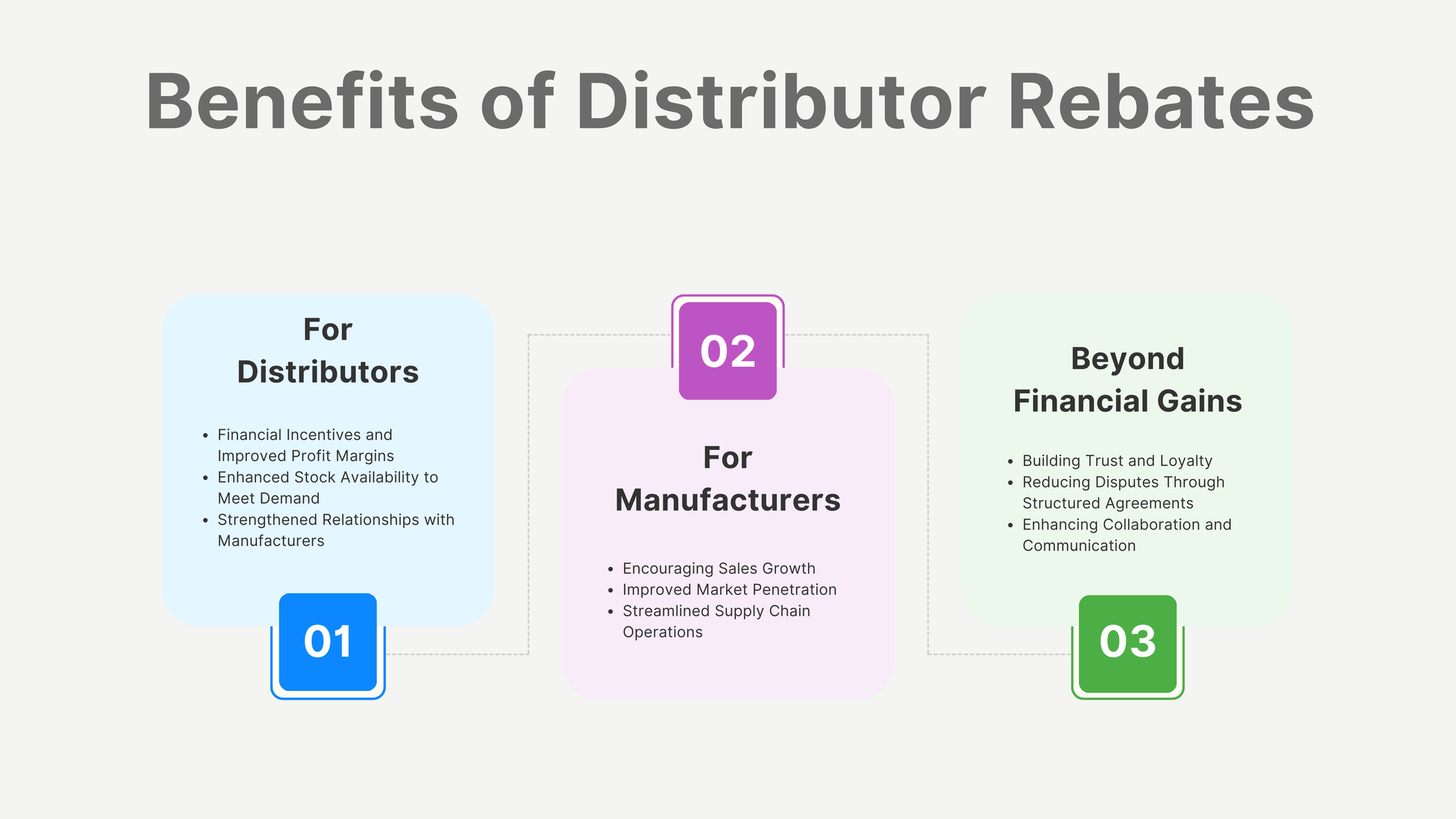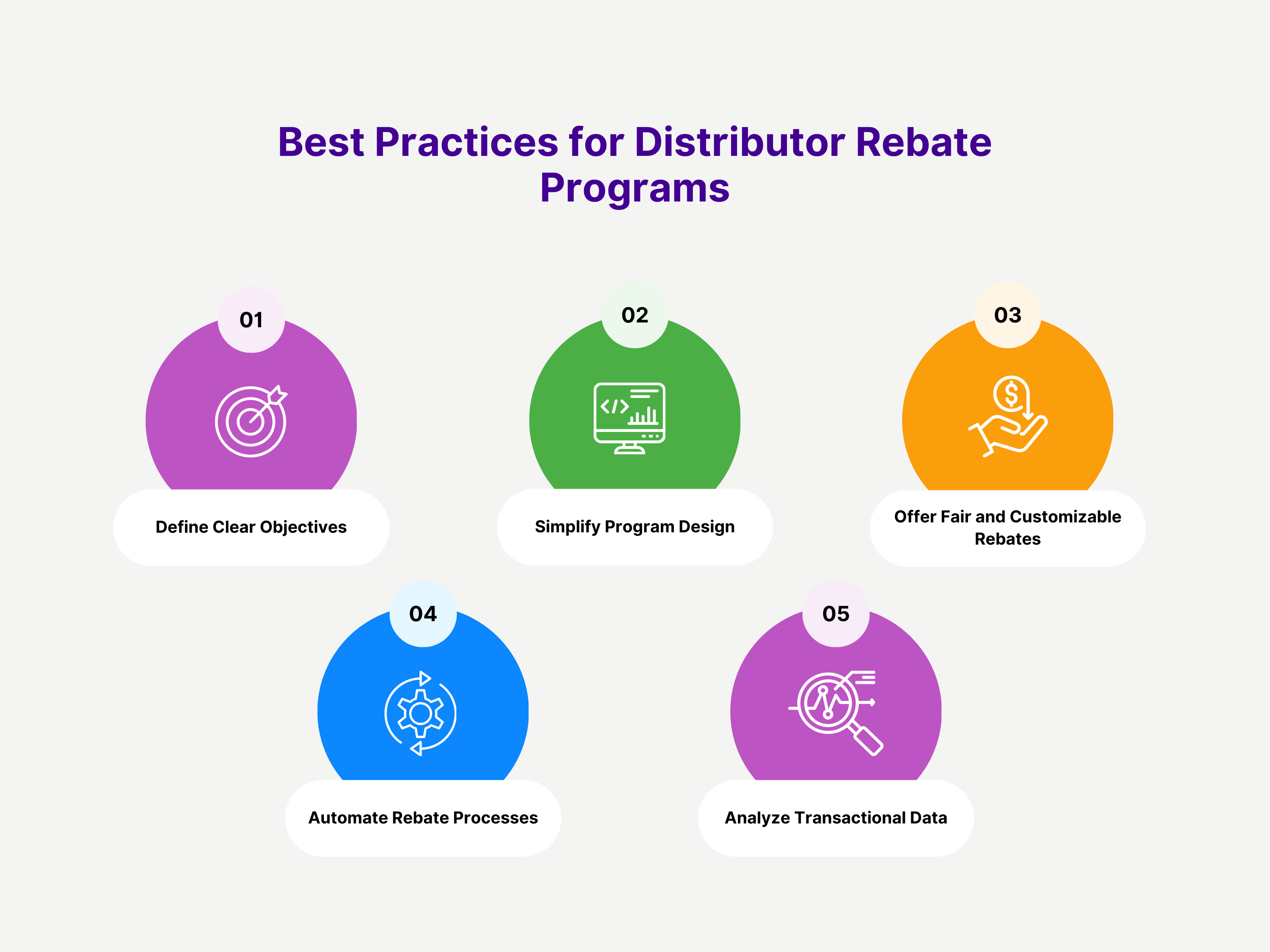What are Distributor Rebates?

Distributor rebates also referred to as trade or channel rebates, are financial incentives offered by manufacturers to distributors based on specific performance metrics. Rebates are a structured way for manufacturers to encourage distributors to purchase and sell more of their products to improve revenue and to expand market reach. Typically, these rebates are outlined in contractual agreements and are paid out periodically, such as quarterly or annually, once the performance criteria are met.
This guide aims to offer a detailed understanding of distributor rebates, exploring their types, how they work, and the many benefits they bring to both manufacturers and distributors.
Table of Contents:
- What Are Distributor Rebates?
- Types of Distributor Rebates
- How Distributor Rebates Work?
- Benefits of Distributor Rebates
- Best Practices for Distributor Rebate Programs
- Role of Technology in Distributor Rebate Management
Jump to a section that interests you, or keep reading.
What Are Distributor Rebates?
Distributor rebates, also known as trade or channel rebates, are financial incentives provided by manufacturers to distributors based on specific performance metrics.
The primary mechanism of distributor rebates involves offering monetary rewards or discounts to distributors upon meeting predefined criteria. These criteria might include reaching certain sales thresholds, expanding market share, or successfully introducing new products into the market. Rebates are usually paid out at regular intervals—such as quarterly or annually—based on the performance period agreed upon between the manufacturer and the distributor.
The overarching goal of distributor rebate programs is to incentivize distributors to increase their purchases and prioritize the manufacturer’s products over competitors’. This approach enables manufacturers to boost sales, secure market penetration, and achieve growth objectives. For distributors, these programs provide an opportunity to enhance profit margins while fostering stronger business relationships with manufacturers.
Types of Distributor Rebates
Distributor rebate programs can be categorized based on their structure and objectives, offering various incentives to align distributor actions with manufacturers’ goals. Below are the main types:
1. Volume-Based Rebates
Volume-based rebates reward distributors for achieving specific purchase or sales volumes during a defined period. These programs encourage distributors to buy in larger quantities, ensuring consistent product flow and helping manufacturers meet revenue goals.
2. Growth-Based Rebates
Growth-based rebates are designed to incentivize distributors to achieve year-over-year growth in sales. This type of rebate program pushes distributors to increase their efforts and expand market share, often targeting specific products or regions where growth potential is high.
3. Incentive-Based Rebates
Incentive-based rebates are tied to specific distributor actions, such as introducing new product lines, securing authorizations, or promoting underperforming inventory. These rebates encourage distributors to take targeted actions that align with a manufacturer’s strategic priorities, such as launching new products or expanding market reach.
4. Mix-and-Match Rebates
Mix-and-match rebate programs reward distributors for purchasing combinations of products. This type of rebate encourages distributors to stock a broader range of a manufacturer’s offerings, thereby increasing product diversity in the market and driving incremental sales across multiple categories.
Vendor Rebates vs. Customer Rebates
-
Vendor Rebates: These are payments made by manufacturers to distributors based on their purchasing behavior, such as meeting volume thresholds or promoting specific product lines. Vendor rebates are a direct incentive for distributors to increase orders and prioritize the manufacturer’s products.
-
Customer Rebates: In contrast, customer rebates are offered by distributors to end customers as a way to encourage loyalty and drive repeat purchases. These rebates often take the form of discounts or cashback offers, providing customers with financial incentives to remain committed to a particular distributor.
How Distributor Rebates Work?

Distributor rebates function as structured financial incentives designed to reward specific distributor actions that align with manufacturers' goals. Here’s a detailed breakdown of how the process operates:
1. Negotiation and Agreement
At the outset, manufacturers and distributors negotiate the terms of the rebate program. This includes defining clear objectives, such as increasing purchase volumes or promoting specific product lines. Both parties agree on the conditions, performance metrics, and timeframes, which could range from quarterly to annual cycles. A well-structured agreement sets the foundation for a transparent and mutually beneficial program.
2. Tracking Sales and Performance
Accurate tracking of sales and performance metrics is essential for the success of rebate programs. Manufacturers rely on reliable data from distributors to measure progress against predefined goals, such as meeting volume thresholds or driving year-over-year growth. Clear documentation of sales transactions minimizes disputes and ensures alignment with rebate criteria.
3. Rebate Calculation Methods
The calculation of rebates varies based on the program’s design. Two common methods include:
-
Flat Rate Calculations: A fixed rebate percentage applied uniformly across all eligible sales. For example, if a distributor purchases $100,000 worth of products at a 5% rebate rate, they would receive $5,000.
-
Tiered Rate Calculations: Rebates increase as distributors reach higher purchase volumes or performance milestones. For instance, a distributor might earn 3% for sales up to $50,000, 5% for sales between $50,001 and $100,000, and 7% for sales exceeding $100,000. This tiered structure motivates distributors to strive for higher volumes.
These calculation methods allow flexibility in tailoring the program to specific objectives, whether to encourage baseline purchases or reward exceptional performance.
4. Payment and Reconciliation
After the rebate period ends, manufacturers reconcile the data and verify whether distributors have met the agreed-upon criteria. Payments are then processed, typically through direct transfers or credits, ensuring distributors receive their rebates promptly. An accurate reconciliation process builds trust and reduces disputes by confirming that all terms are met and payments are calculated correctly.
Benefits of Distributor Rebates

Distributor rebates offer significant advantages to both distributors and manufacturers. Here’s how they benefit both parties:
For Distributors:
-
Financial Incentives and Improved Profit Margins: Distributors benefit directly from financial rewards based on their performance, which can significantly boost their profit margins. The rebates they earn from manufacturers incentivize higher sales and enable them to generate additional revenue with minimal upfront investment.
-
Enhanced Stock Availability to Meet Demand: As distributors increase their purchases to qualify for rebates, they often ensure that they maintain adequate stock levels. This helps them meet customer demand more efficiently, especially when products are in high demand or subject to seasonal fluctuations.
-
Strengthened Relationships with Manufacturers: A well-structured rebate program fosters trust and long-term partnerships between distributors and manufacturers. Distributors are motivated to prioritize manufacturers who offer attractive rebates, leading to deeper collaboration and an ongoing commitment to mutual business success.
For Manufacturers:
-
Encouraging Sales Growth: By offering rebates, manufacturers can stimulate higher sales volumes among their distributors. Rebates serve as a powerful tool for driving purchases, especially for products that may require extra motivation to sell. This increased sales activity directly contributes to the manufacturer's revenue growth.
-
Improved Market Penetration: Rebates encourage distributors to promote the manufacturer’s products more aggressively, often leading to broader market penetration. Distributors are incentivized to target new customers, extend their reach, and increase the brand’s presence across different segments or geographic areas.
-
Streamlined Supply Chain Operations: As distributors purchase products in higher volumes to meet rebate conditions, manufacturers can better forecast demand, optimize production schedules, and improve supply chain efficiencies. This leads to more predictable inventory and smoother operations, reducing costs associated with overstocking or stockouts.
Beyond Financial Gains:
-
Building Trust and Loyalty: Rebate programs help establish a foundation of trust. Distributors are more likely to remain loyal to manufacturers who consistently offer clear, fair, and valuable rebates. This trust is instrumental in maintaining long-term business relationships and securing repeat purchases.
-
Reducing Disputes Through Structured Agreements: A structured rebate system minimizes confusion and misunderstandings between distributors and manufacturers. By outlining specific conditions, payment terms, and expectations, both parties are less likely to engage in disputes, reducing time spent on conflict resolution and ensuring a smoother partnership.
-
Enhancing Collaboration and Communication: The implementation of a rebate program encourages regular communication between manufacturers and distributors. This open exchange of data, sales performance, and inventory levels fosters better cooperation, ensuring both parties are aligned in their efforts to grow the business.
Distributor rebates serve as a mutually beneficial tool that strengthens the supply chain, fosters loyalty, and drives growth for both distributors and manufacturers.
Best Practices for Distributor Rebate Programs

To maximize the effectiveness of distributor rebate programs and ensure smooth management, businesses should adhere to best practices that streamline operations, enhance relationships, and improve outcomes. Below are key best practices that ensure success:
Define Clear Objectives
Setting clear, measurable goals is essential to the success of any rebate program. Manufacturers and distributors should define specific targets such as increasing sales volume, expanding market share, or incentivizing purchases of new products. Having defined objectives allows both parties to track performance, evaluate the program’s effectiveness, and make necessary adjustments. Whether aiming for increased revenue, customer retention, or inventory movement, clearly defined goals serve as the foundation of the rebate strategy and help align all stakeholders.
Simplify Program Design
The simplicity of a rebate program can greatly impact its effectiveness. Terms and conditions should be easy for both customers and internal teams to understand. Rebate thresholds, eligibility criteria, and deadlines must be clearly outlined and communicated to avoid confusion and ensure smooth implementation. If the program is overly complex, distributors and customers may be discouraged from participating or may struggle to adhere to requirements, leading to missed opportunities or incorrect payments. Simplified program design ensures transparency and enhances program participation.
Offer Fair and Customizable Rebates
Offering competitive and fair rebates is crucial for maintaining engagement. Tailoring rebates to encourage higher spending and reward loyalty can foster stronger relationships and drive more sales.
-
Tiered Rebates for Increased Spending: Implementing tiered rebate structures is an effective way to motivate distributors to increase purchases. By offering higher rebates for greater spending, distributors are incentivized to meet or exceed purchasing thresholds, which benefits both parties.
-
Exclusive Incentives for Loyal Customers: Offering personalized or exclusive rebates for loyal distributors strengthens the relationship between the manufacturer and the distributor. These incentives can be based on factors such as long-term purchasing history or commitment to the brand, fostering a deeper sense of loyalty and encouraging repeat business.
Automate Rebate Processes
Manual rebate management is time-consuming and error-prone, leading to inefficiencies and missed opportunities. Implementing rebate management software can streamline the process, ensuring accurate calculations, faster processing, and automated tracking of rebates. By automating rebate management, businesses can reduce the administrative burden, minimize errors, and ensure that all rebate transactions are processed promptly and correctly. Additionally, automation allows for scalability, meaning businesses can handle a growing volume of transactions without sacrificing accuracy.
Analyze Transactional Data
Data analytics plays a critical role in optimizing rebate programs. By analyzing transactional data, businesses can monitor the performance of rebate programs, identify trends, and make data-driven decisions to improve outcomes.
Tracking key metrics, such as the effectiveness of different rebate types, customer participation rates, and the impact on sales growth, provides valuable insights. With this information, manufacturers can fine-tune rebate offerings, adjust thresholds, and understand customer purchasing behavior. Continuous data analysis helps businesses understand which rebate structures are most effective and which customer behaviors can be further incentivized for greater impact.
Role of Technology in Distributor Rebate Management
The integration of technology into distributor rebate management significantly enhances efficiency, accuracy, and overall program effectiveness. Key technological solutions include rebate management software, integration with ERP systems, and advanced data analytics tools. These technologies streamline processes, reduce manual intervention, and provide valuable insights into program performance.
Rebate Management Software
Rebate management software is essential for automating the tracking, calculation, and reconciliation of rebates. By automating these processes, businesses can reduce the likelihood of errors and delays associated with manual entry. The software ensures that rebate eligibility, terms, and calculations are accurate, improving the reliability of the rebate program. Moreover, it helps save time by eliminating the need for manual tracking and processing, which frees up resources for other strategic initiatives. With the software handling the complexity of rebate management, distributors and manufacturers can focus on driving growth and improving relationships rather than dealing with administrative challenges.
Integration with ERP Systems
Integrating rebate management software with ERP (Enterprise Resource Planning) systems facilitates seamless data sharing and reporting between departments. This integration enables real-time updates on sales, inventory, and rebate status, ensuring that all relevant teams have access to accurate and timely information. It allows for smooth communication between finance, sales, and inventory management departments, which is crucial for maintaining up-to-date records of rebates owed and payments processed. Additionally, integration with ERP systems enhances the visibility of rebate data, making it easier to reconcile rebates with financial statements and forecast future rebate liabilities more accurately.
Data Analytics
Data analytics plays a crucial role in assessing the performance of rebate programs and understanding customer behavior. By analyzing transactional data, businesses can gain insights into which products or rebate programs are driving the most sales and where improvements are needed. Analytics tools allow manufacturers and distributors to evaluate program ROI, identify trends, and track the effectiveness of specific rebate offers. These insights help refine rebate strategies and ensure that the programs remain aligned with business goals, ultimately improving the efficiency and impact of rebate incentives. The ability to analyze data also aids in detecting potential misuse or inconsistencies in rebate claims, enhancing the overall integrity of the program.
Technology-driven solutions are transforming distributor rebate management by automating processes, ensuring accuracy, and providing deep insights into program performance. As a result, businesses can improve operational efficiency, reduce errors, and maximize the value of their rebate programs.
Conclusion
Distributor rebates serve as a strategic tool to strengthen relationships between manufacturers and distributors, creating an environment where both parties can grow together. These programs not only promote financial gains but also build trust, encourage loyalty, and enhance communication. Through well-structured rebate agreements, manufacturers can incentivize distributors to purchase more products, ultimately helping them achieve long-term success and competitive advantages.
